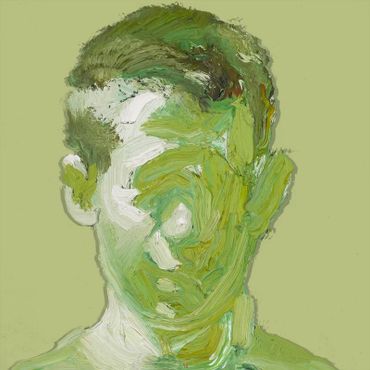The paintings on glass of the past two decades - a surface usually used to protect artworks - seem to have prompted the even more radical investigations of Compendium 2. Applied like slathered tattoos, Turner’s portraits reside on slick square skins that are transparent, with the fields behind the figures left empty of paint. The blank glass fields reveal various colored wall panels that set off the images and enhance their floating spectral presence. The transparent thickness of the glass causes the figures’ silhouettes to form thin shadows that seem to shimmer. The slight distance from the wall emphasizes the film of paint that embodies each human image. Close likeness of his subjects is for Turner, as he calls it, only a “byproduct”; indulging his own emotional response to a painting as he makes it, he explains that a kind of “capturing can’t not happen.” But always the independent life of the painting takes precedence over the capturing.
two series of abstractions push and pull thick paint into stimulating energy fields. the off-white and pale blue abstractions are patch-work arrangements of tex- tures and forms, revealing through subtle gradations the ability of paint to speak its own nuanced language. the works using color were made slowly over the past fifteen years using leftover paint scraped from Turner’s palette onto glass surfaces after stu- dio sessions. overturning the spontaneity of abstract expressionism, Turner creates slow boiled stews of troweled paint, bringing the aesthetic decision-making process to a crawl so that a composition gradually reveals itself. Like other practitioners of thick- ness such as Jess, Ronald Bladen, and Jay DeFeo, turner uses globs of paint as asser- tions of the medium’s power and meaty appeal. off-kilter shades of orange, vermilion, and lime ornament the works like scabrous brooches. turner’s slo-mo method involves a re-purposing of paint and an abandonment of color choice. excess paint finds a place for itself. Arranging these concatenations over time, Turner creates a kind of found Ab ex, created in a sense by the feelings and desires of paint itself. Finally, in the sculp- ture, Asylum (2014), six empty paint tubes are arranged on end on top of a mint green pedestal. Like bronze figurines, Turner’s painted gold heroes perform a dance celebrat- ing lives spent in the creation of art.
-Michael Duncan
Monroe











This website uses cookies.
We use cookies to analyze website traffic and optimize your website experience. By accepting our use of cookies, your data will be aggregated with all other user data.